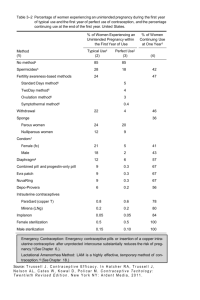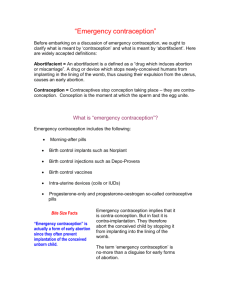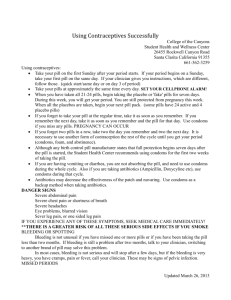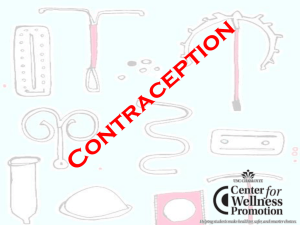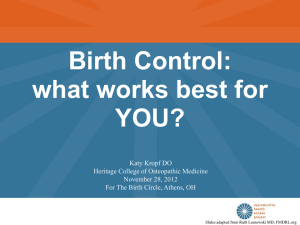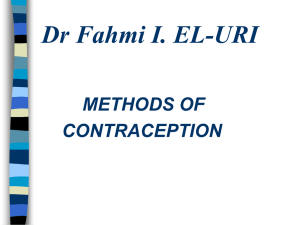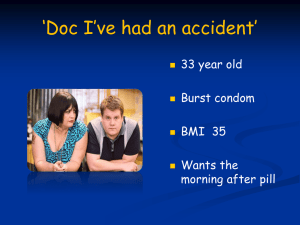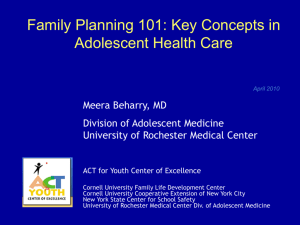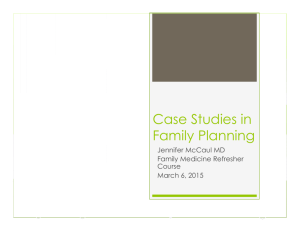Contraception
advertisement
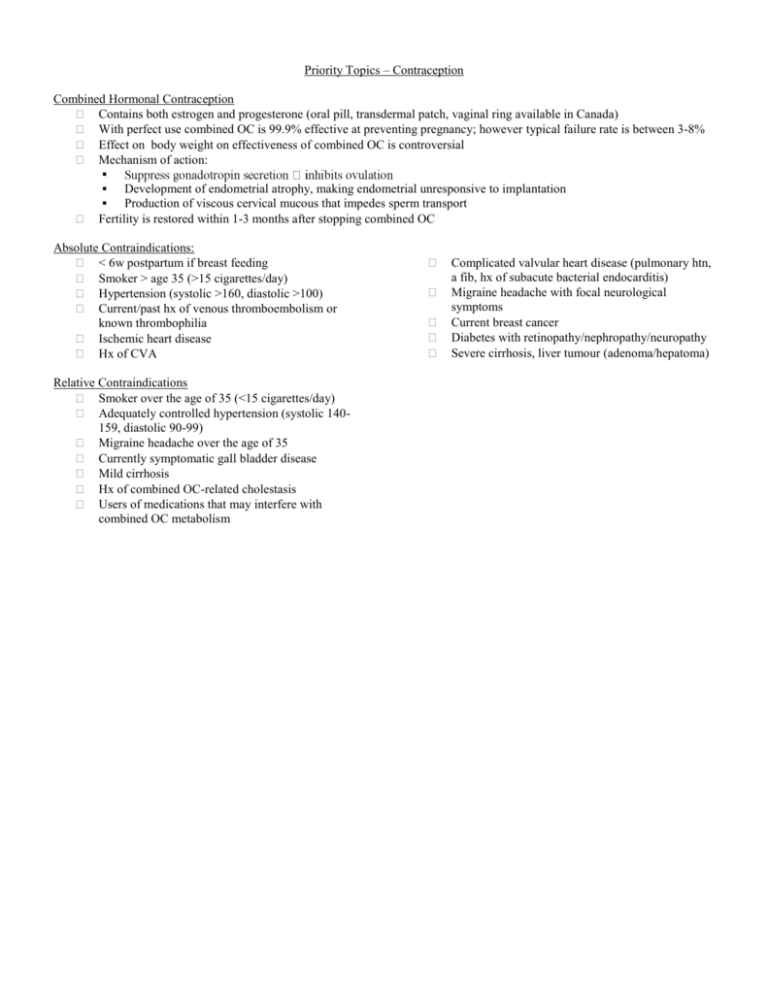
Priority Topics – Contraception Combined Hormonal Contraception Contains both estrogen and progesterone (oral pill, transdermal patch, vaginal ring available in Canada) With perfect use combined OC is 99.9% effective at preventing pregnancy; however typical failure rate is between 3-8% Effect on body weight on effectiveness of combined OC is controversial Mechanism of action: Development of endometrial atrophy, making endometrial unresponsive to implantation Production of viscous cervical mucous that impedes sperm transport Fertility is restored within 1-3 months after stopping combined OC Absolute Contraindications: < 6w postpartum if breast feeding Smoker > age 35 (>15 cigarettes/day) Hypertension (systolic >160, diastolic >100) Current/past hx of venous thromboembolism or known thrombophilia Ischemic heart disease Hx of CVA Relative Contraindications Smoker over the age of 35 (<15 cigarettes/day) Adequately controlled hypertension (systolic 140159, diastolic 90-99) Migraine headache over the age of 35 Currently symptomatic gall bladder disease Mild cirrhosis Hx of combined OC-related cholestasis Users of medications that may interfere with combined OC metabolism Complicated valvular heart disease (pulmonary htn, a fib, hx of subacute bacterial endocarditis) Migraine headache with focal neurological symptoms Current breast cancer Diabetes with retinopathy/nephropathy/neuropathy Severe cirrhosis, liver tumour (adenoma/hepatoma) Side Effects Most common reasons for non-compliance of combined OC Irregular bleeding – (10-30% in first month of use) – greatest likelihood during first 3 cycles then Risks causes of irregular bleeding if continues Breast tenderness and nausea – usually improves with time;less likely forcombined OC (↓) containing lower amounts of estrogen Possible: Weight gain and Mood changes– placebo controlled trials failed to show any association Rare: Chloasma:switching to a different pill will not help, and hyperpigmentation may never completely disappear Venous thromboembolism – 3-4x higher in users of combined OC than non-users – 1 – 1.5/10,000 users/year of use MI – in women taking combined OC containing >50 mcg ethinyl estradiol, MI rates increase 3x, no shown risk with combined OC with <50 mcg Stroke – specifically combined OC users with hypertension are at higher risk Gall bladder disease – stone formation Breast cancer – controversial Cervical cancer – controversial Counselling Prior to Starting Any Contraception Instructions on how to take combined OC o Conventionally combined OC is started during first 5 days of menstrual cycle, or on the first Sunday after menses begin (a backup method is not required for prevention of pregnancy provided no pills have been missed.) o Quick start method – start right away, after ruling out a pregnancy (back up method of o o f/u visit should be organized to review experience, satisfaction and compliance If using the patch, it should be started on the first day of menses (this will be the patch change day) Info on potential side effects Non-contraceptive benefits of combined OC Addressing common myths and misconceptions Option for “continuous” use Discussing risks and warning signs – including when to seek medical care o Especially amenorrhea – can occur in 2Discussing what to do if pills are missed o Missing pills at beginning or end of 21 day cycle lengthens hormone-free period, increasing the risk of ovulation. Forgetting tablets in second or third week of 21 day cycle is unlikely to increase risk of ovulation as long as hormone-free interval doesn’t exceed 7 days Emphasizing dual protection (use of condom to prevent STIs and HIV infections) Information about emergency contraception in the event of a missed pill Instructions Regarding Missed Pills If you miss 1 pill, take it as soon as you remember If you miss 2 pills in a row during the first 2 weeks of the pack, take 2 pills on the day you remember and 2 on the following day. Use a backup method of contraception if you have sex in the 7 days after you miss the pills. If you have had unprotected intercourse after missing a pill, use emergency contraception. If you miss 2 pills in a row in the third week of the pack, throw out the remainder of the pack and start a new pack on the day you remember. You may not have a period this month. If you had unprotected intercourse after missing a pill, use emergency contraception. If you miss 3 pills in a row, throw out the remainder of the pack and start a new pack on the day you remember. If you had unprotected intercourse after missing a pill, use emergency contraception. Use a backup method of contraception if you have intercourse in the first 7 days of the new pack. You may not have a period this month. Drug Interactions Antiestradiol) g ethinyl - rifampicin and griseofulvin have been shown to interact. Progestin Injectable, oral or as an intrauterine device Depot medroxyprogesterone acetate (DMPA) – injectable. Failure rate of <0.3%/year Oral progestin only pill (POP) – failure rate of 0.5% when used perfectly, typical failure rate 510% Increases the viscosity of cervical mucus8 and induces endometrial atrophy Useful for women who have contraindications to combined OC Absolute contraindications (WHO): known or suspected pregnancy, unexplained vaginal bleeding, current diagnosis of breast cancer Relative contraindications (WHO): severe cirrhosis, active viral hepatitis, benign hepatic adenoma Side Effects o Risks If irregular bleeding persists after first 6 months, underlying causes of abnormal vaginal bleeding should be r/o o Once this is done management options include: Increasing DMPA dose to between 225 and 300 mg for 2-3 injections Decreasing interval between doses Supplemental estrogen therapy such as 0.625 mg of conjugated equine estrogen orally x 28 days NSAID agents, such as ibuprofen 400-800 mg BID x 10 days Adding combined OC pill for 1-3 months Hormonal side effects such as headache, acne, decreased libido, nausea, breast tenderness rcise DMPA: ↓bone mineral density,;some studies suggest there is an improvement in BMD after DMPA is discontinued increase risk Starting DMPA and POP DMPA Should be started within first 5 days of menses; if switching from combined OC to DMPA, DMPA should be given within first 5 days of stopping combined OC If given within first 5 days of menstrual cycle, contraceptive effect is achieved within 24 hours, but can be given at any time during menstrual cycle if pregnancy is ruled out If given after first 5 days of menstrual cycle, back up method should be used for at least 1 week Given as 150 mg IM injection Q12Weeks POP is usually started on first day of menstrual cycle, but can be started at any time as long as pregnancy is excluded – there is no pill free interval, and back up method should be used for first 7 days Late/Missed Injections If it has been <14 weeks since last injection, then next injection can be given If it has been >14 weeks, but no intercourse within last 10 days and serum bHCG is negative then injection can be given, and back up method should be used x2 weeks If it has been >14 weeks, but pt has had intercourse in last 10 days, serum bHCG must be done (and negative) and injection can be given, but back up method required x2 weeks, and repeat bHCG should be done in 2 weeks Instructions Regarding Missed Pills If a pill is missed, it should be taken as soon as possible. If the pill use is delayed by more than 3 hours, a backup method of birth control should be used for the next 48 hour If 2 or more pills in a row have been missed, then the individual must take 2 pills per day for 2 days and use a backup method of birth control for 48 hours. In the event of a missed or late pill, the use of emergency contraception may be considered if appropriate INTRAUTERINE DEVICES Types and Statistics IUD TYPES Failure Duration Copper 1.26/100 WY 5 yrs (lit. says 30mos) Mirena 0.9/100 WY 5 yrs * 100WY is 100 woman years assuming regular intercourse. * The overall ectopic rate is lower than for persons using other forms of contraception. Ectopic 0.25/100 WY 0.02/100 WY MOA (1) Copper IUD - A foreign body reaction inhibits fertilisation by changing the biochemical and morphological characteristics of the endometrium. - Cu ions inhibit sperm motility - NO inhibition of ovulation (2) Mirena IUD - Levonorgestral released very slowly from vertical arm results in thickened mucous which decreases sperm penetration. - Some women become anovulatory - Foreign body reaction inhibits fertilisation (endometrial decidualization and gland atrophy) Indications - Long-term protection - Adjunct to breast feeding Contraindications - Pregnancy - Post Septic abortion bleeding - Cancer (Endo/CVX) (CI toward mirena only) Relative Contraindications - HIV (high risk or Test positive) - Benign Trophoblastic Disease - Unreliable use of other contraception - Mennorhagia/dysmenorrhea - STI/PID (current/common or in 3 mos) - Abnormal Uterus (bicornate, fibroids...) - Puerperal sepsis - Abnormal Vag. - Copper allergy - Breast Cancer - Between 48hrs and 4weeks Postpartum - High risk for STI (recurrent, sex trade...) - Ovarian Cancer Non-Contraceptive Benefits - Copper: decreased endometrial cancer secondary to unknown MOA - Mirena: Decrease menorrhagia (in 74 - 97%) AND decrease endometrial hyperplasia while on Tamoxifen Side Effects Copper: - 65% have increased bleeding. Approx 12 days of spotting in the first month - Pain is a common consequence which is often caused by FB reaction; however, malposition, infection and pregnancy must be ruled out. So, do a detailed Vag. Exam, BHCG, CBC, STI testing and consider an US to confirm placement. Mirena - Bleeding is often increased in the first 1-3 months with irregular spotting; however, 74-97% will have decreased bleeding. - Amenorrhea is seen in 16-35% at 1 year. If a pt is amenorrheic check BHCG. If there is no pregnancy then no need to worry. - Pain is the same as for the the copper IUD. - Functional Ovarian Cysts occur in 30% of women. most will resolve spontaneously and require no investigation. - Hormonal symptoms (Breast tenderness, Acne) are uncommon and are maximal at 3 months with gradual decline thereafter. Risks - Uterine perforation (0.1%) - Expulsion (2-10%)... RF = previous, Nullip, <4-6wks post partum - Ectopic Pregnancy (lower than normal rate, but increased risk if you do get pregnant) - Pregnancy Loss (75% will abort if IUD left in with intrauterine pregnancy.... If this occurs attempt GENTLE extraction) - STI (RR = 3.8); not due to IUD itselfIf bacterial infection occurs treat with ABX. IUD can be left in situ unless PID develops) Lost IUD - It has either gone up or fallen out. - Detailed vaginal exam... it is often still there if it has fallen out - If not found -> US (? intrauterine) -> AXR (?intra abdominal) EMERGENCY CONTRACEPTION There are only THREE forms of emergency contraception available in canada 1) Plan B - Two 750mcg doses of levonorgestral given either 12 hours apart or as a 1.5mg single dose - 89% of pregnancies that would have occurred are prevented; Effective in the first 72hours, but efficacy decreases after 12 hours - Safe in pregnancy 2) Yuzpe - Two doses of 0.1mg estradiol and 0.5mg levonorgestral given 12 hours apart. - Any similar regime from conventional OCP can be used. (see Appendix) - 75% of pregnancies that would have occurred are prevented; Effective in the first 72hours, but efficacy decreases after 12 hours - Safe in pregnancy 3) IUD insertion - Should only be completed with the COPPER IUD - Can be inserted up to 5 days post-coitus - 98.7% of pregnancies that would have occurred are prevented NOTE Mifepristone is not available in Canada at this point in time. Hormonal EC - MOA: Not completely understood, but there are many theories. Overall consensus is that it inhibits ovulation. - CI: Essentially none (allergy) - FU: BHCG if no menses in 21 days. MOST women will have return of normal cycle in 21 days - Side Effects : Nausea, Vomitting, Dizziness, Fatigue (All more common with Yuzep method) IUD EC - MOA: Inhibits ovulation - CI: Pregnancy, Copper allergy, current STI - FU: BHCG if no menses in 21 days. - Side Effects: Pain, bleeding, PID, perforation, Expulsion
